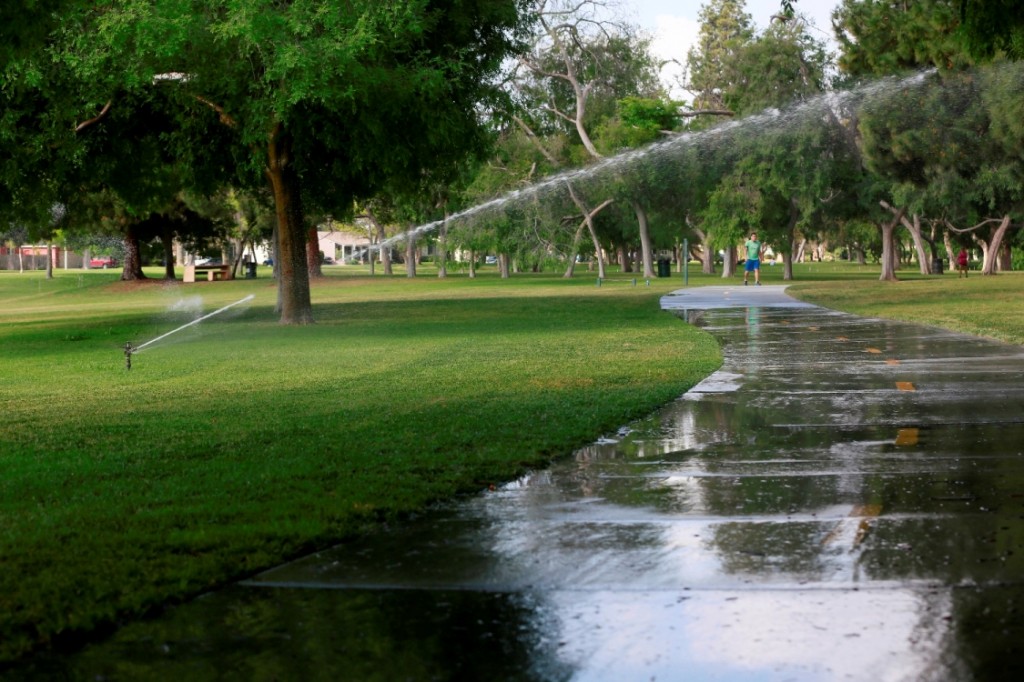- California Assembly OKs highest minimum wage in nation
- S. Korea unveils first graphic cigarette warnings
- US joins with South Korea, Japan in bid to deter North Korea
- LPGA golfer Chun In-gee finally back in action
- S. Korea won’t be top seed in final World Cup qualification round
- US men’s soccer misses 2nd straight Olympics
- US back on track in qualifying with 4-0 win over Guatemala
- High-intensity workout injuries spawn cottage industry
- CDC expands range of Zika mosquitoes into parts of Northeast
- Who knew? ‘The Walking Dead’ is helping families connect
No more playing nice: California names, shames water wasters

Water sprinklers are used at Heartwell Park in Long Beach, Calif., on Thursday, April 2, 2015. California Gov. Jerry Brown on Wednesday, ordered a 25 percent overall cutback in water use by cities and towns, but not farms, in the most sweeping drought measures ever undertaken by the nation’s most populous state. (AP Photo/Nick Ut)
SACRAMENTO, Calif. (AP) — California is done with gentle nudges and polite reminders to deal with its devastating drought.
State regulators are naming and shaming local water departments that have let water wasters slide — and forcing them to slash water use by as much as a third. They say it’s necessary as California reservoirs, and the snow on mountains that is supposed to refill them, reach record lows.
The drought has no clear end in sight, but it’s up to hundreds of local agencies, from small irrigation districts to the city of Los Angeles, to make sure California has enough water to get through it.
Since Gov. Jerry Brown declared a drought emergency last year, they’ve largely taken a soft, educational approach to curtail water use. But that’s no longer enough, he says.
In response, state regulators have drafted plans that show how much each community has conserved and assigns mandatory water reduction targets of up to a third to each one. The highest targets are set for those that use the most water.
“It’s going to require some major changes in how those communities think about, use and manage their water, but it is possible,” said Heather Cooley of the nonprofit Pacific Institute.
The excuses cities have given for pitiful conservation, including hot weather and earlier cutbacks, are no longer a free pass.
That means Los Angeles — which has a million more people than it did 40 years ago, but uses the same amount of water — would have to cut its use by a fifth.
Ways of meeting these ambitious targets include increasing the frequency of water waste patrols, hitting guzzlers in the wallet with higher water prices and expanding incentives to rip up lawns for drought-tolerant shrubs and bushes. Those who don’t meet the targets or take steps to conserve face $10,000-a-day fines if they don’t adopt new water restrictions or change rates as demanded by the state, although regulators have been wary of using similar powers before.
State officials say residential conservation through turning off the sprinklers, taking shorter showers and doing less laundry is the most effective way to boost statewide water supplies in a drought.
Not all cities were at risk of running out of water and didn’t feel the same pressure to conserve. Some had enough water in local storage to weather the drought. Other local elected officials risked the wrath of constituents for hiking rates or imposing far-reaching restrictions.
“If it’s the state telling them what they have to do, that takes the heat off of local officials,” said Ellen Hanak, a water expert at the Public Policy Institute of California.
The new strategy is a result of Brown’s executive order to make temporary and lasting changes to water consumption. Brown planned a meeting Wednesday on the drought with representatives from water agencies, agricultural interests and environmental groups.
The toughest hurdle for this new strategy is getting people who haven’t been conserving over the last few years to suddenly make drastic cuts. Water agencies are not getting any money to hire water cops or acquiring any authority to turn off taps.
Hitting customers in the wallet is an effective way of bringing change: Santa Cruz and the San Ramon-Dublin area slashed water use more than 30 percent after slapping big fines on residents who went over water limits.
Bigger bills may not be enough to motivate the owners of mansions on the hills overlooking San Diego. They are served by California’s top water guzzling agency, the Santa Fe Irrigation District.
Jennifer Parks, a spokeswoman for the district, said the agency plans to finally fine offenders and is willing to ration if necessary.
In some communities, drastic cuts could threaten the local economy. The man-made oasis of Palm Springs, in the desert, attracts thousands each year to dozens of lush golf courses, hotels and verdant landscapes, but now faces a mandate to cut water use by 35 percent, or 2 billion gallons, over nine months.
“There is nothing like it we’ve ever had to face in terms of how we live our lives,” said Craig Ewing, the board president of the Desert Water Agency which serves Palm Springs.
The board previously rejected increasing water rates as water use rises, but Ewing says the state mandates will likely force the agency to reconsider. Four years into the drought, it will now ramp up water waste enforcement, particularly for guests using vacation homes, and communities are ripping up grass in favor of drought-tolerant shrubs and bushes.
“It will be a new welcome, rather than acres of green lawns,” Ewing said.















